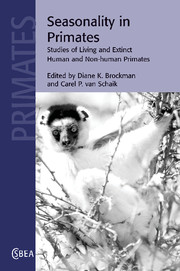Book contents
- Frontmatter
- Contents
- List of contributors
- Preface
- Part I Introduction
- Part II Seasonal habitats
- Part III Seasonality and behavioral ecology
- 3 The influence of seasonality on primate diet and ranging
- 4 Seasonality in predation risk: varying activity periods in lemurs and other primates
- 5 Physiological adaptations to seasonality in nocturnal primates
- 6 Seasonality and long-term change in a savanna environment
- 7 Day length seasonality and the thermal environment
- 8 Seasonality in hunting by non-human primates
- 9 Human hunting seasonality
- Part IV Seasonality, reproduction, and social organization
- Part V Seasonality and community ecology
- Part VI Seasonality and human evolution
- Index
- References
4 - Seasonality in predation risk: varying activity periods in lemurs and other primates
Published online by Cambridge University Press: 10 August 2009
- Frontmatter
- Contents
- List of contributors
- Preface
- Part I Introduction
- Part II Seasonal habitats
- Part III Seasonality and behavioral ecology
- 3 The influence of seasonality on primate diet and ranging
- 4 Seasonality in predation risk: varying activity periods in lemurs and other primates
- 5 Physiological adaptations to seasonality in nocturnal primates
- 6 Seasonality and long-term change in a savanna environment
- 7 Day length seasonality and the thermal environment
- 8 Seasonality in hunting by non-human primates
- 9 Human hunting seasonality
- Part IV Seasonality, reproduction, and social organization
- Part V Seasonality and community ecology
- Part VI Seasonality and human evolution
- Index
- References
Summary
Introduction
A primate's activity cycle is one of its most fundamental characteristics as it determines when an individual engages in the basic behaviors required for survival. The allocation of activity over a single 24-hour period varies substantially across and even within species. Although the biological mechanisms that regulate vertebrate activity cycles and the abiotic cues associated with them have been the subject of much research, there has been relatively less emphasis on the adaptive and evolutionary correlates of the different ways in which animals distribute activity and rest across the 24-hour day.
Most primates display either a nocturnal or a diurnal activity cycle. Although diurnality frequently is associated with haplorhine primates, along with their superior visual acuity and trichromatic vision (at least in the catarrhines), several strepsirrhine species are also habitually day-active (Tattersall 1982; Mittermeier et al. 1994), and at least three taxa display an X-linked polymorphism that permits trichromacy in females (Tan & Li 1999). Furthermore, not all haplorhines are diurnal; exceptions include the tarsier and the owl monkey, taxa that secondarily evolved a nocturnal activity cycle from diurnal ancestors (Martin 1990).
The morphological and behavioral dichotomy that exists between nocturnal and diurnal species is striking, especially within the visually adapted primate order, and it would seem difficult to shift from day activity to night activity, or vice versa, once adaptations for either of these activity periods have evolved. Nonetheless, a third activity cycle observed in primates requires such transitions between day and night activity.
- Type
- Chapter
- Information
- Seasonality in PrimatesStudies of Living and Extinct Human and Non-Human Primates, pp. 105 - 128Publisher: Cambridge University PressPrint publication year: 2005
References
- 11
- Cited by



